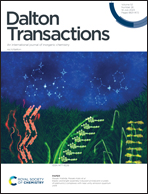Efficient and zero thermal quenching Sm3+-activated Li2LaTiTaO7 phosphor for white LEDs†
Abstract
In this work, we prepared a new orange-red phosphor Li2La1−xTiTaO7:xSm3+ (abbreviated as LLTT:Sm3+) for white light-emitting diodes (w-LEDs). Its crystal structure, microstructure, photoluminescence characteristics, luminescence lifetime and thermal quenching properties were studied in depth. The LLTT:Sm3+ phosphor shows four intense emission peaks at 563, 597, 643, and 706 nm when excited at 407 nm. Thermal quenching is caused by the dipole–quadrupole (d–q) interaction of Sm3+ ions, and the optimum doping concentration of Sm3+ is x = 0.05. Meanwhile, the LLTT:0.05Sm3+ phosphor has a high overall quantum yield (QY = 59.65%) and almost no thermal quenching. The emission intensity at 423 K is 101.5% of the initial value at 298 K, while the CIE chromaticity coordinates barely change as the temperature rises. The fabricated white LED device exhibits excellent CRI and CCT values of 90.4 and 5043 K, respectively. These findings demonstrate that the LLTT:Sm3+ phosphor has promise in w-LED applications.



 Please wait while we load your content...
Please wait while we load your content...